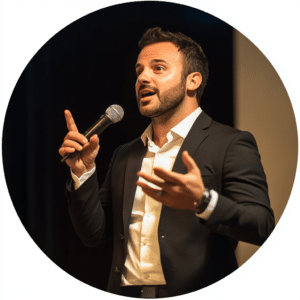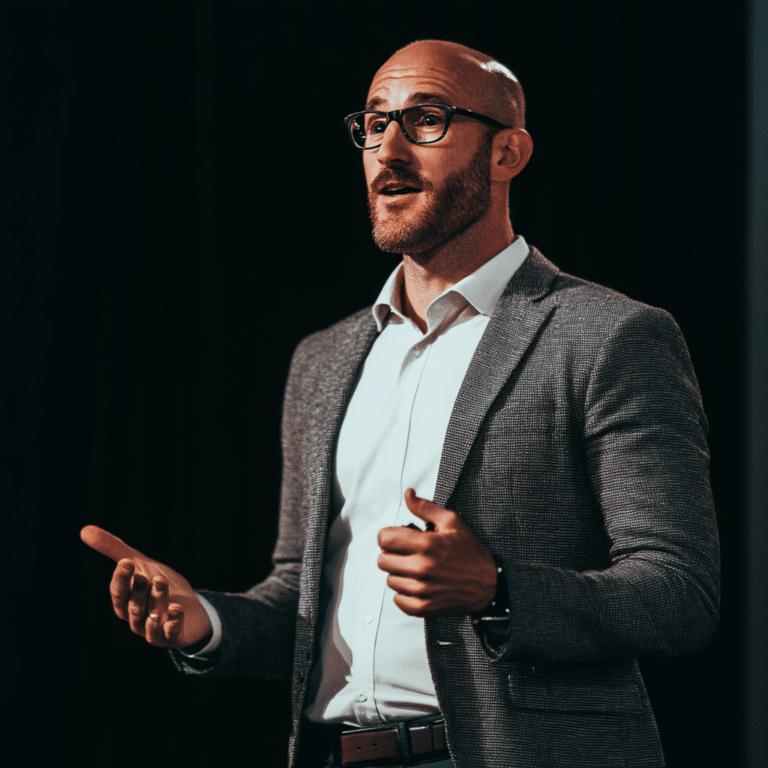Understanding the Dynamics of Career Speaker Transition
In 2024, the landscape for career speakers is vastly different from previous years, necessitating a richer understanding of the dynamics involved in transitioning successfully. With the advent of digital platforms and the rise of virtual engagements, mastering career speaker transition requires not just talent but also strategic acumen. This section delves into the core elements that define a successful transition for career speakers today.
Career speaker transition demands more than eloquence; it entails a comprehensive strategy to thrive amid fierce competition and evolving audience expectations. Remember how rapidly communication transformed during the pandemic? Speakers had to pivot overnight to digital platforms. It’s a whole new ball game now with digital engagements forming the crux of speaker visibility and outreach. With the shifting tides, let’s dive deeper into the secrets of navigating this transition.

Secret #1: Leveraging Personal Branding
First and foremost, personal branding is essential. One of the keys to a successful career speaker transition lies in the strength of personal branding. Take Simon Sinek, whose consistent branding around “Start With Why” has made him a household name in motivational speaking. Developing a clear, strong personal brand helps to distinguish a speaker from the competition and creates a loyal audience base.
Creating a personal brand is about more than a catchy slogan. It involves a blend of professional image, social media presence, and a unique value proposition. Your personal brand must resonate deeply with your target audience. Effective speaker branding Strategies can set you apart and cement your identity in the minds of your audience.

| **Aspect** | **Details** |
|---|---|
| Signpost Word | Description |
| Introduction | Now let’s consider the complexities involved in a career speaker transition. |
| Role of a Career Specialist | At present, a career transition specialist helps individuals move from one stage of their career to the next by focusing on their job search, career readiness, and qualifications. |
| Key Duties | Next, the specialist’s duties typically include conducting mock interviews and helping with resume writing. |
| Recognizing Transferable Skills | First, it is crucial for individuals to recognize their transferable skills when looking to switch careers with no direct experience. |
| Establishing a Transition Plan | Similarly, establishing a transition plan is an essential part of moving smoothly from one career stage to another. |
| Filling Skill Gaps | In the other hand, individuals must fill in the gaps in their skill set to become competitive in their new field. |
| Gaining Experience | Next, gaining experience that demonstrates new skills is pivotal for validating one’s readiness for a career transition. |
| Networking | Finally, networking with the right people can create opportunities and open doors that might otherwise be inaccessible. |
| Summary | As a recap, successful career transitions involve recognizing transferable skills, planning, skill development, gaining relevant experience, and effective networking. |
| Timeline | We now turn to a typical timeline for a career transition, which can vary but often spans several months to a year, depending on the complexity of the career shift and individual circumstances. |
Secret #2: Adapting to Digital Platforms
Next, adapting to digital platforms is crucial. In today’s digital age, adapting to online speaking platforms is no longer optional but imperative. Consider the example of Brené Brown, who successfully transitioned her speaking engagements to virtual platforms during the pandemic, reaching a wider audience than ever before.
Learning how to handle tools like Zoom, Microsoft Teams, and even specialized virtual event software can significantly expand your reach and engagement. This shift allows for a more dynamic interaction with your audience. By embracing these digital avenues, you can make your mark as a versatile and accessible speaker in the digital space.

Secret #3: Networking Beyond the Stage
And yet, networking remains a pivotal element, but modern speakers need to go beyond traditional settings. Look at how Gary Vaynerchuk utilizes platforms like LinkedIn and Twitter to connect with business leaders and potential clients. Building a robust network through social media, online communities, and webinars can empower speakers to find new opportunities and collaborate with industry influencers.
Networking is not limited to face-to-face events. Dive into the digital trenches! Engage with your audience through meaningful interactions and collaborative ventures. Developing genuine relationships on platforms like LinkedIn, Twitter, and even in webinars, can tremendously amplify your career prospects.

Secret #4: Continuous Learning and Certification
If you think that’s shocking, consider this: The most successful career speakers are those who invest in continuous learning. For instance, former President Barack Obama transitioned into speaking and writing, leveraging his experience while continually educating himself on global affairs and leadership.
Obtaining certifications from organizations like Toastmasters or the National Speakers Association can bolster credibility and refine one’s oratory skills. This commitment to ongoing education not only enhances your skill set but also signals to your audience that you are dedicated to your craft.

Secret #5: Harnessing Data-Driven Strategies
Similarly, using data-driven strategies to tailor content to specific audiences can significantly enhance a speaker’s impact. Mel Robbins, known for her expertise in neuroscience and productivity, uses data to fine-tune her messaging and connect effectively with her audience. Analyzing audience feedback, engagement metrics, and market trends enables speakers to customize their presentations for maximum impact.
Data isn’t just for analysts. By embracing data-driven approaches, you can identify what resonates with your audience and continuously refine your content. This strategy ensures that your speeches are impactful and always relevant.
Secret #6: Crafting Compelling Narratives
Next, storytelling is at the heart of compelling speeches. Speakers like Oprah Winfrey and Tony Robbins have mastered the art of weaving powerful narratives that resonate and inspire. Understanding the elements of a good story—conflict, resolution, and a clear takeaway—can elevate any speech from mundane to memorable.
Crafting compelling narratives engages the audience on a deeper emotional level. By weaving relatable stories into your presentations, you can leave a lasting impression that transcends typical speeches.
Secret #7: Expanding Revenue Streams
Lastly, career speakers must diversify their income streams to mitigate risks and capitalize on various opportunities. For example, self-help author and speaker Rachel Hollis has not only given talks but also created best-selling books, online courses, and hosted conferences, ensuring multiple revenue avenues.
Developing products, consulting, and coaching can provide financial stability and growth. Expanding your revenue streams adds layers of resilience to your career, allowing you to tap into diverse markets and opportunities.
Innovative Strategies for a Future-Proof Career Transition
Expanding on the previous points, adapting to the future means staying ahead of emerging trends. The utilization of AI to personalize content delivery, embracing virtual reality for immersive experiences, or employing blockchain for securing intellectual property represents just a few ways speakers can innovate.
By staying agile and open to new methodologies, career speakers can remain relevant and successful amidst rapid changes. A future-proof career transition isn’t optional—it’s essential.
Final Thoughts: Empowering Your Career Speaker Transition Journey
In conclusion, transitioning successfully as a career speaker involves much more than just delivering powerful speeches. It’s about establishing a personal brand, leveraging digital platforms, expanding networks, pursuing continuous learning, using data-driven approaches, crafting engaging narratives, and diversifying revenue streams.
With these strategies, aspiring and established speakers alike can confidently navigate the evolving landscape of public speaking and achieve lasting success in 2024 and beyond. Embrace these secrets, innovate, and prepare to captivate audiences everywhere.
TCAA encourages you to explore these dynamics fully by visiting resources like “
Insights into Career Speaker Transition
Transitioning into a career as a speaker can be as thrilling as watching the Super Bowl’s kick of destiny. Did you know many successful keynote Speakers began their journeys over a casual meal at one of the popular Federal Hill restaurants? It’s true! Networking in lively environments often sparks the most inspiring conversations and opportunities.
Fun Facts and Stories
Interestingly, some speakers have a history as exciting as a game of speedball. This intense mix of soccer and handball requires quick thinking and adaptability, skills essential for a career speaker transition. Speaking of adaptability, many professionals who pivot into speaking often come from various backgrounds. These speakers, having faced personal challenges like the death of a parent—a life-altering experience—bring a unique perspective that resonates deeply with audiences.
Digging Deeper
A successful transition into a speaking career involves embracing unconventional marketing techniques. For example, consider the case of speakers who use creative speaker marketing techniques—from personalized merchandise to captivating social media content—to build their brand. This approach has proven beneficial in standing out in a competitive market. Growth also sometimes requires revisiting past experiences, much like the fascinating return of Abercrombie with its revamped brand, showing that reinventing oneself can lead to a triumphant comeback.
Trivia and Anecdotes
While many assume the path of a career speaker is straightforward, some of the best-known speakers have tales as twisted as plotlines in a suspense novel. For instance, many have adopted practices from retail strategies, mirroring the savvy adjustments Abercrombie made during its return to relevancy. Such resilience showcases the importance of evolving and learning continuously in this field.
In sum, transitioning into a speaking career is filled with opportunities for discovery and personal growth. With the right mindset and strategic approach, as highlighted by these fun trivia and tips, you’ll be well on your way to becoming one of the most successful keynote speakers.

How to transition between speakers?
Now let’s consider that to smoothly transition between speakers during an event or presentation, you can briefly summarize the key points made by the first speaker and then introduce the next one with a segue that highlights their relevance or expertise. It’s like handing off a baton in a relay race.
What does a career transition specialist do?
Next, a career transition specialist helps people move from one stage of their career to the next by focusing on their job search, career readiness, and qualifications. They conduct mock interviews and assist in resume writing to make sure you’re ready for the next step.
What is the career transition process?
At present, the career transition process involves recognizing your transferable skills, establishing a plan, filling in skill gaps, gaining relevant experience, and networking. It’s about making a shift in your career path with some thoughtful planning and efforts.
How do you talk about career transitions?
Altogether, talking about career transitions should focus on how you assessed your skills, identified your goals, and took proactive steps to move from your old role to a new one. It’s about showing a clear and logical path of growth and adjustment.
What is an example of transition to another speaker?
Similarly, an example of transitioning to another speaker could be: “Thank you, Alex, for those insightful comments on digital marketing. Now let’s turn our attention to Sarah, who will delve into the practical applications of these strategies.”
What are examples of transitions?
Now let’s consider transitions in speech, they often use phrases like “first,” “next,” “finally,” or even questions like “Have you thought about…?” to smoothly guide the audience from one topic to another. They keep the flow logical and engaging.
How long does a career transition take?
In the other hand, the length of a career transition varies based on factors like industry, demand, your preparedness, and networking. It can be as short as a few months or take several years, depending on how quickly you can meet the new role’s requirements.
What is the purpose of career transition?
Next, the purpose of a career transition is to help you move from one stage of your career to the next, either by changing industries, roles, or advancing in your current field. It’s about finding a better fit for your skills, interests, and career goals.
What does a career transition coach do?
If you think that’s shocking, a career transition coach works with you to identify your strengths, set realistic career goals, create actionable plans, and support you through the process. They’re like a personal trainer but for your career.
What are the 4 stages of career transition?
Now let’s consider the four stages of career transition: self-assessment, exploration, decision-making, and action. It starts with understanding yourself, exploring options, making informed decisions, and then taking steps to achieve your goals.
What are the 4 steps of transition?
Next, the four steps of transition include: acknowledging the need for change, preparing for it, implementing the plan, and evaluating the results. It’s a cycle that helps you adapt effectively to any new situation.
What are the 4 steps in the career process?
Finally, the four steps in the career process are similar: self-assessment to understand your strengths, setting career goals, making a plan to achieve those goals, and taking action to move forward. It’s about being deliberate and strategic in your career path.
How do I transition to a new speaker?
Now let’s consider how to transition to a new speaker in a phone conversation. You might say something like, “That covers my part on project planning. Now, John will talk about budgeting.” It’s short and gives a clear hand-off to the next person.
How do I pass to another speaker?
In the other hand, to pass to another speaker during a presentation, you can summarize what you’ve said, and then directly introduce the next speaker with a brief mention of their topic or expertise. It keeps the audience engaged and sets the stage for the next part.
How do you introduce two speakers?
At present, introducing two speakers can be done by first giving a short intro to the first speaker, then after they finish, segue by thanking them and introducing the next person. It’s about keeping the introductions concise and relevant.
Which technique is commonly used in speech transitions?
Altogether, a commonly used technique in speech transitions is the use of signpost words, like “first,” “next,” or “finally.” These words help signal to the audience that you’re moving from one point to the next, making it easier to follow along.


















